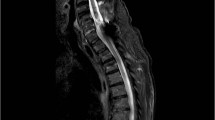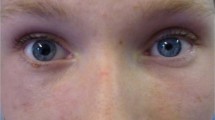Abstract
Study design:
Case report.
Objectives:
To report a case of reversible posterior leukoencephalopathy (RPL) in a patient with traumatic cervical spinal cord injury.
Setting:
Neurologic inpatient Unit, Lahey Clinic, Burlington, MA, USA.
Methods:
A 55-year-old woman with a residual spastic quadriparesis from a traumatic C5–C6 fracture developed, during an assisted cough maneuver, sudden severe headache followed by cortical blindness in the setting of high blood pressure. Magnetic resonance imaging (MRI) showed T2 hyperintensities in the subcortical white matter of both medial occipital lobes and left post-central gyrus.
Results:
Elevation of the head of the bed during subsequent cough maneuvers with occasional use of sublingual nifedipine prevented further episodes of acute arterial hypertension and development of new symptoms. Repeat MRI of the head done one month later was normal.
Conclusion:
RPL can occur in the setting of autonomic dysreflexia in patients with traumatic cervical cord injury. The prompt recognition of this syndrome is of importance to prevent further morbidity and mortality in patients with spinal cord injury.
Similar content being viewed by others
Introduction
Reversible posterior leukoencephalopathy (RPL) is a well-known syndrome that typically presents with a headache, seizures and visual loss, often in the setting of accelerated hypertension. This entity has become increasingly recognized over the years and is associated with hypertensive encephalopathy, eclampsia, chemotherapeutic agents and antirejection therapy.
We report a patient with spastic quadriparesis who developed RPL in the setting of autonomic dysreflexia (AD).
Case report
Patient is a 55-year-old woman with spastic residual quadriparesis from a traumatic C5–C6 fracture ASIA Impairment Scale (AIS)-C that occurred 6 months prior to hospitalization. After her spinal cord injury, she developed arterial hypotension requiring treatment with fludrocortisone acetate.
The day of admission, the patient woke-up at 0100 hours needing to cough. An aide performed an assisted cough maneuver and shortly after this, the patient developed a sudden severe throbbing headache, followed by bilateral blindness. Systolic blood pressure was 213 mm Hg. The emergency medical technicians arrived 40 min later, the patient's blood pressure was 160/100 mm Hg. In the emergency room, her blood pressure was back to her baseline 78/41 mm Hg. Her examination revealed the presence of cortical blindness and spastic quadriparesis. Emergent non-contrast head CT scan was normal. A subsequent MRI (magnetic resonance imaging) done 5 h after symptom onset showed T2 hyperintensities in the subcortical white matter of both medial occipital lobes (Figure 1 -top) and left post-central gyrus, with normal MRAs of the head and neck. Shortly after the MRI was performed, the patient's vision normalized. While hospitalized, the patient's blood pressure fluctuated widely, with elevated levels occurring during cough maneuver, particularly with vigorous maneuvers and if the patient was lying supine. The patient had an indwelling Foley catheter that was working properly. No bowel dysfunction was found. Elevation of the head of the bed during the cough maneuver associated with occasional use of sublingual nifedipine prevented further episodes of acute hypertension. No further clinical episodes occurred during her admission and follow-up MRI done 1 month later showed complete resolution of the T2 hyperintensities (Figure 1 -bottom).
Discussion
Reversible posterior leukoencephalopathy syndrome was first described by Hinchey et al.1 in 1996 and is characterized by headaches, visual disturbances, seizures, altered mental status and occasional focal signs. This entity has been reported in a variety of medical conditions including abrupt rise in blood pressure.
Magnetic resonance imaging usually shows edema predominantly in the white matter, most frequently involving the parieto-occipital regions of the brain. The predilection for the posterior regions of the brain is likely the result of less sympathetic innervation of the vertebrobasilar and posterior cerebral arteries as compared with the anterior cerebral vasculature.2 However, in severe cases, other areas of the brain can also be affected.
Vasogenic cerebral edema due to loss of cerebral autoregulation and breakdown of the blood–brain barrier due to the sudden increase in blood pressure and direct toxic effect of chemotherapeutic agents or antirejection therapy on vascular endothelium are considered the two potential mechanisms for this syndrome.1
When promptly recognized and treated, symptoms and radiographic abnormalities are usually reversible. Occasionally if left untreated, this condition can lead to strokes and be fatal.3
In our patient, we believe that the RPL syndrome was associated with the sudden elevation of her blood pressure due to AD.
Autonomic dysreflexia is a potentially dangerous complication of subacute and chronic spinal cord injury usually occurring with lesions above the splanchnic sympathetic outflow, that is T6. The most dramatic clinical feature of this syndrome is the sudden elevation of blood pressure usually triggered by any noxious stimuli below the level of the cord lesion, most often related to lower urinary or gastrointestinal tract disorders, such as bladder distension or infection, fecal impaction, hemorrhoids, anal fissures and abdominal trauma. The majority of AD resolves without any significant consequences; however, serious complications such as intracerebral hemorrhage, convulsions, cardiac arrhythmias and neurogenic pulmonary edema can occur with the lack of timely treatment. Acute management of AD includes identification and removal of any precipitants, and if no cause is found, antihypertensive drugs such as sublingual nifedipine or captopril can be used. Neuroablative techniques are reserved for resistant cases.4, 5
We postulate that in our patient the vigorous assisted cough maneuver in a supine position triggered the sudden elevation of the blood pressure with consequent development of RPL syndrome.
The prompt recognition of this syndrome is of vital importance to prevent further morbidity and mortality in patients with spinal cord injury.
References
Hinchey J, Chaves C, Appignani B, Breen J, Pao L, Wang A et al. A reversible posterior leukoencephalopathy syndrome. N Engl J Med 1996; 334: 494–500.
Edvinson L, Owman C, Sjoberg NO . Autonomic nerves, mast cells, and amine receptors in human brain vessels: a histochemical and pharmacological study. Brain Res 1976; 115: 337–393.
Lamy C, Mas JL . Reversible posterior leucoencephalopathy. A new syndrome or a new name for an old syndrome? Presse Med 2001; 30: 915–920.
Khastgir J, Drake MJ, Abrams P . Recognition and effective management of autonomic dysreflexia in spinal cord injuries. Expert Opin Pharmocother 2007; 8: 945–956.
Jacob C, Thwaini A, Rao A, Arya N, Shergill IS, Patel HR . Autonomic dysreflexia: the forgotten medical emergency. Hosp Med 2005; 66: 294–296.
Author information
Authors and Affiliations
Corresponding author
Rights and permissions
About this article
Cite this article
Chaves, C., Lee, G. Reversible posterior leukoencephalopathy in a patient with autonomic dysreflexia: a case report. Spinal Cord 46, 760–761 (2008). https://doi.org/10.1038/sc.2008.38
Received:
Revised:
Accepted:
Published:
Issue Date:
DOI: https://doi.org/10.1038/sc.2008.38
Keywords
This article is cited by
-
Acute visual loss in a patient with spinal cord injury
Spinal Cord Series and Cases (2017)
-
Sexual function and autonomic dysreflexia in men with spinal cord injuries: how should we treat?
Spinal Cord (2012)
-
Reversible cerebral vasoconstriction syndrome associated with autonomic dysreflexia
The Journal of Headache and Pain (2010)




